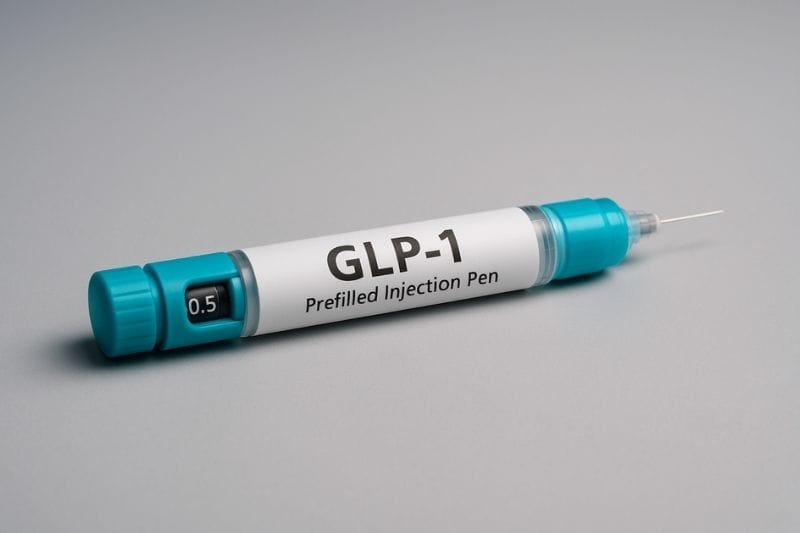What are GLP-1 agonists and antagonists, and how do they work? These terms describe how certain medications interact with the body’s natural GLP-1 hormone, which plays an important role in appetite, hunger and blood sugar control. Understanding the basics can make the different brands, effects and safety information much clearer.
GLP-1 medications are widely discussed in weight loss and diabetes conversations, but the language can sound technical and a bit off-putting at first. Once you understand the core ideas, though, they are actually quite straightforward.
What GLP-1 Actually Is
GLP-1 stands for Glucagon Like Peptide 1. It is a hormone made in the gut and released after you eat. It has several key jobs in the body, including:
• Encouraging insulin release to help manage blood sugar
• Slowing down how quickly food leaves your stomach
• Affecting appetite and fullness signals in the brain
These actions work together to influence how hungry you feel, how much you eat and how efficiently your body handles the energy from food. Because of this, medications that target GLP-1 can have a powerful impact on both appetite and blood sugar, which explains their use in diabetes treatment and long term sustainable weight management and support.
A Short History of GLP-1 Medications
The story of GLP-1 medication begins in the 1980s, when researchers first identified the hormone and its effects on blood sugar and appetite. Over the next couple of decades, scientists developed drugs that could mimic its action to help people with type 2 diabetes. The first GLP-1 receptor agonist was approved for diabetes treatment in 2005. These early drugs had to be injected daily and were mainly aimed at improving blood sugar control.
A major shift came in 2017 when semaglutide was approved for diabetes. It was longer lasting, so it only needed to be injected once a week, and clinical studies showed significant weight loss as a side effect. This led to further trials focused specifically on weight management. In 2021, semaglutide under the name Wegovy was approved for weight loss. Since then, new medications have been developed, and research continues into even more effective treatments, including those that target multiple hormones at once.
GLP-1 Agonists Explained
A GLP-1 agonist mimics or boosts the effects of your body’s own GLP-1. In simple terms, it acts as if there is more GLP-1 in circulation. This strengthens the natural signals that reduce appetite and steady blood sugar levels. Many people using GLP-1 agonists notice that they feel full more quickly, stay full for longer and reduce their overall food intake without following rigid diets. Over time, this often leads to weight loss.
Some well known medications, such as semaglutide, are GLP-1 receptor agonists. They are designed to work on the same receptors as the natural hormone but more strongly or for longer, which is why they are typically taken weekly rather than daily.
GLP-1 Antagonists Explained
A GLP-1 antagonist does the opposite job. Instead of increasing GLP-1 activity, it blocks or reduces it. These are mainly used in research to study what happens when GLP-1’s effects are switched off. They are not weight loss medications, but they do help scientists understand the hormone’s role more clearly. You might see the word antagonist mentioned in studies or medical articles, but it is less relevant to everyday use.
The Main GLP-1 Brands and Their Effectiveness
Several GLP-1 based medications are now well known in the UK and around the world. Each works in a slightly different way but they all fall under the broader category of GLP-1 receptor agonists.
- Ozempic contains semaglutide and was originally developed for type 2 diabetes. Weight loss was a well known side effect, which is partly what led to newer versions being licensed specifically for weight management.
- Wegovy also contains semaglutide but is licensed for weight loss rather than diabetes. In studies, Wegovy led to average weight loss of around 15 percent of starting body weight when combined with lifestyle changes.
- Rybelsus is an oral tablet version of semaglutide. It can be easier to take for some people but its effects tend to be slightly less pronounced than injectable versions.
- Mounjaro contains tirzepatide, which targets both GLP-1 and another hormone called GIP. In studies this has produced average weight loss of around 20 percent of starting body weight, which is higher than semaglutide.
- Retatrutide is a newer drug currently in trials. Early studies suggest it may be even more effective than current options, but it is not yet available for general use.
The figures above come from clinical trials, where people are usually monitored closely and given structured lifestyle support alongside medication. Results in real life can vary depending on individual factors, adherence and the kind of support people have in place.
A Short Note on Compounded and Non-Prescription Versions
As interest in GLP-1 medications has grown, some online sellers and private clinics have begun offering versions of these drugs that are compounded or supplied outside standard medical routes. These are sometimes marketed as cheaper or more accessible alternatives, but quality and safety can vary. There have been reports of counterfeit products, inconsistent dosing and a lack of proper follow up care. Anyone considering GLP-1 medication should always do so under the guidance of a qualified medical professional, using licensed products from reliable sources. This ensures proper monitoring, support and safety.
Side Effects and What We Know About Long Term Use
Like any medication, GLP-1 agonists can cause side effects. The most common ones involve the digestive system. Many people notice:
• Nausea or queasiness, especially early on
• Constipation or diarrhoea
• A noticeable drop in appetite, sometimes leading to rapid weight loss
For most, these settle as the body adjusts, but the severity varies. Some people experience only mild effects while others need extra support from their prescribing team to manage symptoms.
The long term picture is still being studied. GLP-1 medications have been used in diabetes care for several years, so there is useful data, but their widespread use for weight loss is more recent. Ongoing research is exploring their long term impact when used primarily for weight management. Regular medical follow up is important for anyone taking these drugs over time.
Why Understanding This Matters
Understanding how these medications work makes it easier to read headlines, navigate medical information and recognise overblown marketing claims. GLP-1 agonists can play a useful role, but they are not magic solutions. Knowing the basics puts their effects in context and makes it easier to see how they fit into the bigger picture of health and weight management.
Weight Loss Is Always About More Than One Factor
Medication can influence appetite and create opportunities for progress, but lasting results rely on habits, accountability and support. Many of my nutrition and accountability coaching clients focus on building routines that make healthier choices easier, from how they plan meals to how they fit activity into their week. Accountability provides structure and helps keep motivation steady during busy periods. These foundations are what keep results going long after medication stops. The medication can open the door, but daily habits are what help you keep walking through it.
GLP-1 FAQs
Are GLP-1 medications safe?
Licensed GLP-1 medications have been through clinical trials and are prescribed under medical supervision. Like all medications, they carry potential side effects and should only be taken when prescribed appropriately.
Are GLP-1 tablets as effective as injections?
Tablets such as Rybelsus can be effective but often produce slightly less weight loss than injectable forms like Wegovy or Mounjaro. The choice depends on medical advice, personal preference and how well the medication works for the individual.
Who can take GLP-1 medication?
GLP-1 medications are usually prescribed for people with type 2 diabetes or those with a higher body weight where other methods have not been successful. Suitability depends on medical history and should always be assessed by a healthcare professional.
Do GLP-1 agonists work on their own?
They can reduce appetite and support blood sugar control, but long term weight loss usually depends on sustainable lifestyle changes alongside medication.
What happens if you stop using GLP-1 medication?
Some people regain weight if habits are not in place. Lifestyle routines and accountability make a big difference to maintaining progress after stopping.
Are the long term effects fully known?
Research is ongoing. So far, data from diabetes use is reassuring, but there is not yet decades of information for weight loss use.
Coaching Support That Focuses on the Whole Picture
Whether you are using GLP-1 medication or focusing on lifestyle changes alone, the right support can make a big difference. I help people lose weight in a realistic way and keep it off through personalised coaching and accountability.
Find out more about my weight loss coaching >
Disclaimer:
This article is for general information only and is not a substitute for medical advice. Always speak to a qualified healthcare professional before starting, changing or stopping any medication, including GLP-1 treatments.




